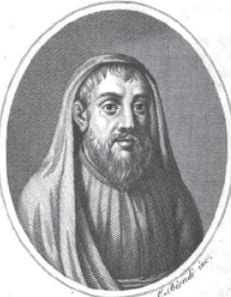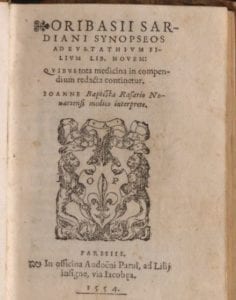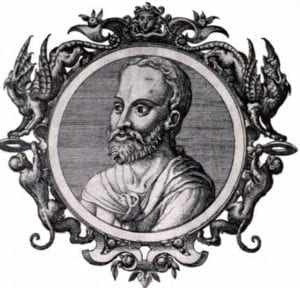
Greek physicians dominated medicine for almost two thousand years, beginning with the school of Hippocrates, of Herophilus and Erasistratus in Alexandria, and continuing after the Roman conquest. Celsus and Galen were in Rome; Dioscorides was in the Roman army during the reign of the Emperor Nero. Aretaeus of Cappadocia practiced sometime during the second century.
Highlighted here are other physicians who practiced in the eastern or Byzantine part of the Roman empire either before or after its division by Theodosius the Great in 395 AD.
Rufus of Ephesus (about 80–150) lived in the time of Emperor Trajan and was one of the most eminent and prolific authors of his times. A thirteenth century Arab physician referred to him “as second to none in his time” and wrote that his greatest work was his book on melancholy. He studied in Alexandria and practiced in Ephesus, and he wrote numerous works, some preserved only in Arabic, on history taking and bedside manners, on the importance of anatomy, on dietetics, gonorrhea, gout, jaundice, poisoning, and diseases of the bladder and kidneys.
Proclus of Rhegium (1st century) practiced in southern Italy and wrote on remedies for gout, dropsy, and sciatica.
Soranus of Ephesus (c. 98–138) practiced medicine and especially gynecology in Alexandria and Rome during the reigns of Trajan and Hadrian. He is noted for a treatise on gynecology describing contraceptive and obstetric delivery measures; and he also wrote On Fractures and Bandages, and On Acute and Chronic Diseases with a chapter on nervous disorders as well as specific instructions on the administration of olive oil. He appears to have enjoyed a great reputation among the ancients.
Antyllus (2nd century) lived in Rome and is noted for his work on treating aneurysms, describing the difference between the traumatic and the degenerative kinds. He is said to have used suction to extract cataracts from the eye, performed tracheotomies, operated on hydroceles, and developed specific criteria on when and how to operate on tumors. He also wrote on several other medical themes such as the importance of walking, jogging, swimming, gymnastics, and of shadow boxing as a method of training.

Oribasius (c. 326–403), born in Pergamum, was physician to Emperor Julian the Apostate. He wrote profusely on medical matters, summarizing the works of Galen and others in seventy books named the Collectiones medicae, with emphasis on childhood diseases, diet in pregnancy, and the choice of nurses for infants. He described the systemic and pulmonary circulation, discerned the existence of capillaries, and did anatomical dissections. In several of his works he mentions rabies, describes the behavior of mad dogs, and recommended cauterizing the wound of persons bitten by a rabid dog. He was the first to use the term ureter.
Adamantius, was Jewish by birth and fled from Alexandria during the expulsion of the Jews from that city by the Patriarch Cyril in 415. He went to Constantinople, was persuaded to embrace Christianity, and then returned to Alexandria. He is the author of a treatise on physiognomy and also wrote on subjects concerning the eye.
Agapius (end of fifth century) was a physician of Alexandria who taught and practiced medicine at Byzantium with great success and reputation. He was said to have acquired immense riches.
Aëtius of Amida (c. 502–575), described as the first Christian physician of note, was court physician to the emperor Justinian I and compiled his Tetrabiblion from the writings of Rufus, Hippocrates, and Galen. He is believed to have been the first physician to mention diphtheria, and his writings contain original ideas about ligating aneurysms and descriptions on obstetrics, gynecology, intestinal worms, and cirrhosis of the liver.
Anthimus (511–534)was a Byzantine physician practicing in the West at the court of the Ostrogoth king Theodoric the Great. He wrote De Observatione Ciborum, a valuable source for dietetics. He discusses the digestive difficulties arising from badly boiled eggs and recommends boiling them in water mixed with vinegar and stirring continually during the process.
Alexander of Tralles (c. 525–605) traveled extensively during his youth, and practiced in Rome until the age of eighty. During the end of his life he wrote a therapeutic handbook for doctors listing in a work titled Therapeutica the treatments he had found effective, discussing specifically neurologic conditions such as epilepsy, paralysis, “lethargy,” and meningitis.

Paul of Aegina (625–690) practiced in Alexandria even after its conquest by the Arabs. Best known for writing an encyclopedic Medical Compendium in seven books, he gave novel descriptions of tracheotomy, tonsillectomy, catheterization of the bladder, lithotomy, inguinal hernia repair, abdominal paracentesis for ascites, and other surgical procedures, including reduction of breast size.
Theophilus Protospatharius (610–641) was a physician at the court of the Byzantine Emperor Heraclius. He was one of the original forerunners of modern urology.
Theophanes Nonnus (c. 920) wrote an outline of medicine dedicated to the Emperor Constantine Porphyrogenitus. In his Epitome de curatione morborum he described the symptoms resulting from poisonous remedies, venomous serpents, and rabid dogs.
Yahya of Antioch (Yaḥya ibn Saʿīd al-Anṭākī) (980–1066), most likely born in Fatimid Egypt, was a Christian physician and historian of the eleventh century. He became a physician, but the anti-Christian pogroms of Caliph Al-Hakim bi-Amr Allah forced him to flee to Byzantine-held Antioch.
Michael Psellos (1018–c. 1078) was a philosopher, historian, politician, naturalist physician, and professor at the High School of Constantinople. In his Chronographia he described in detail the illness and death of Emperor Romanus III, showing his close acquaintance with medical theory and therapeutics. He also wrote about the role of demons in disease and the medicamentary effect of jewels.
Anna Comnena (1083–1153) was a Byzantine princess, scholar, physician, hospital administrator, and historian. Daughter of the Byzantine Emperor Alexios I Komnenos, she also evinced a long-standing awareness of therapeutics and medical theory.
Nicholas Kallikles (1080–1150) was a prominent physician and leading court poet active in the Byzantine court in Constantinople during the reigns of Alexios I Komnenos and John II Komnenos.
Simeon Seth (SEC. XI) a Jewish physician, was the author of Philosophy and Medicine, Properties of Foods, and Lexicon of Botany—encyclopedias of material medica featuring an alphabetical presentation of the beneficial effects of foods. It contains an important number of remedies. Musk, amber and hashish are presented in his work from Arabian books. He noticed camphor’s sedation effect on the genito-urinary tract, and presented the ointments and syrup from Arabian recipes.
Michael Italicus was a Byzantine medical instructor at the Pantokrator Hospital established by Emperor John II Komnenos in 1136. Pantokrator was a medical center at which he lectured and illustrated diseases through patient cases.
Nicholas Myrepsos “The one who makes ointments,” lived around 1241 to 1271. He wrote the Dynameron, divided in 48 chapters, an important work containing 2656 drug formulations, as well as an important number of other pharmaceuticals remedies, based on their action.
Aaron ben Joseph of Constantinople (1260–1320), was an eminent teacher, philosopher, physician, and liturgical poet in Constantinople.
Demetrius Pepagomenus (c. 1261) was court physician of Emperor Michael VIII Palaeologos, who commissioned by him to write a treatise on gout, which he considered caused by a defective elimination of excreta. As a veterinary physician he wrote a treatise on feeding and nursing hawks, also on dogs, their care, diseases, and treatment.
Johannes Actuarius (c. 1275–1328) wrote several books on medicinal subjects, particularly on poisons and an extensive treatise about urines and uroscopy. Around 1299 he considered moving to Thessaloniki, but decided to stay in Constantinople; later he was appointed chief physician to the Emperor.
Demetrios Chloros was a 14th-century physician, astrologer, and priest who was tried for possessing magic books. He was secretary of the patriarch and supervisor of offerings.
References and further reading in Hektoen International
- Aristotle and the four humors
- Aretaeus of Cappadocia, second only to Hippocrates
- Erasistratus
- Pedanius Dioscorides: The first encyclopedia of plants and drugs
- Philosophy of science and medicine series — II: Galen vs. Hippocrates
- Philosophy of science and medicine series — III: Greek science
- Philosophy of science and medicine series — IV: Alexandrian period

Leave a Reply